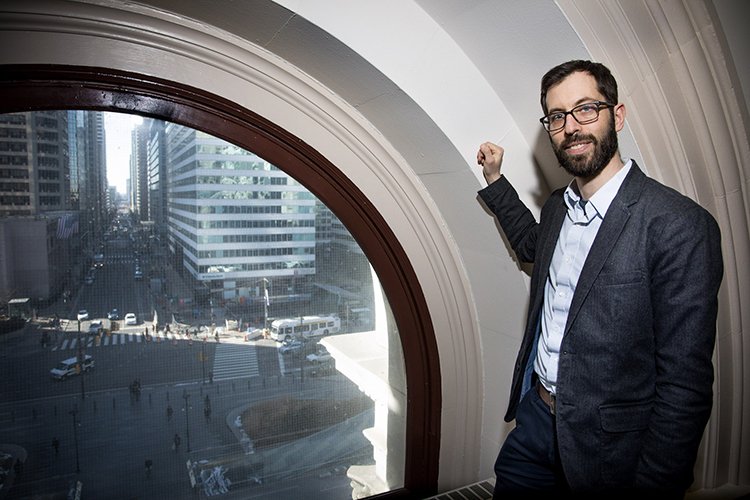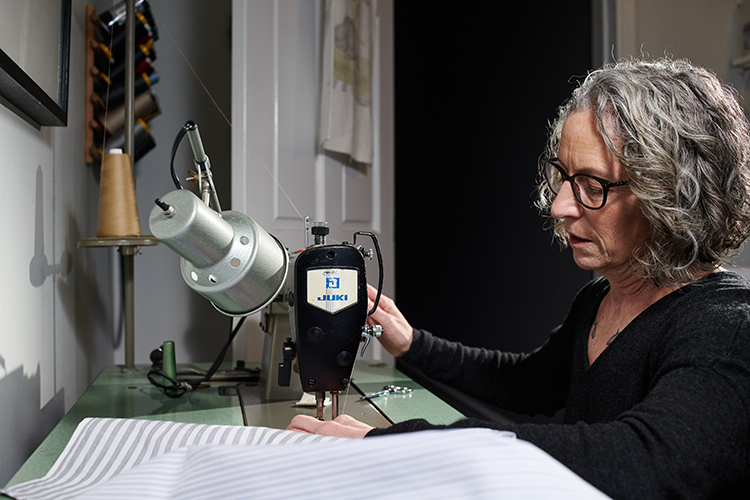Photo: Rachael Warriner
by Kim Post
Program Manager Alon Abramson calls his workplace “basically a startup.” In many respects it looks like a typical government office, but the youthful employees, generous space and handsome street view adds a certain vitality.
The Philadelphia Energy Authority promotes clean energy in the city, helping city departments, businesses and homeowners through a variety of energy generation and efficiency projects.
Its Philadelphia Energy Campaign aims to create 10,000 jobs over the course of 10 years by cutting the energy use of each building it works on by 20 percent, removing 790,000 metric tons of carbon dioxide from the air along the way.
It’s looking to invest $1 billion in clean energy investments.
With just six staff members and several interns, the PEA partners on projects that aim to grow the private sector around clean energy and energy efficiency. The small team is full of diverse skill sets: Abramson is an engineer by training, but the team also boasts experience in business and planning.
“We’re the government, yes, but we try to be really nimble,” Abramson says.
In 2010 the PEA was created as a legal entity independent of the city, similar to the city’s Housing and Parking authorities. Regardless, a look at the PEA offices’ location in City Hall, off a broad hallway lined with judges’ chambers, suggests the division between city and the PEA is not so strong as the legal structure implies.
The reason for their structure is a provision in the Philadelphia Home Rule charter that prevents the city from making deals with private contractors that would last more than four years. More time is a must in the world of private energy projects.
The PEA makes investments in energy projects free from that restriction and then sells the energy to the city. Along these lines, in December it purchased the 70-megawatt output of Adams Solar, a new solar farm in Adams County developed by Community Energy, for the next 20 years. Philadelphia will use that electricity to power 22 percent of its government buildings, working toward one of Mayor Kenney’s campaign promises to commit to 100 percent renewable electricity by 2035.
Six years after its inception, the PEA began developing its energy initiatives, trying to carve out a niche distinct from the city’s own Office of Sustainability. One of its most established is “Solarize Philly,” which Grid reported on this past July, a program that helps to grow the market for solar panels by offering discounted installations through approved installers: Kiss Electrical of Levittown, Moore Energy of Southampton and Solar States of Kensington.
The U.S. Department of Education awarded the PEA a $1.25 million grant in October to develop a curriculum with the School District of Philadelphia that will prepare students to get jobs in clean energy.
“We’re in the solar game to phase ourselves out,” Abramson says, meaning PEA is not looking to permanently subsidize solar power in Philly—it wants to stimulate the private solar sector until it can stand on its own.
“We’re looking to create a market that’s self-sustaining,” he says.
Small-scale pilot projects lie in PEA’s future as it tries out different approaches before exclusively focusing on what is most effective. It is re-evaluating how it ran its small-business energy efficiency program in 2017 and 2018, hoping that a revised version will get more participation. It is also a partner on a project with the Museum of Art, which has the highest energy costs of any city-owned building.
PEA has also become involved with the Water and Sewer Service Line Protection Program. Many homeowners are unexpectedly stuck with an expensive bill when there is a disruption in the lines between the main water and sewer lines—owned by the Philadelphia Water Department—and the pipes in their homes, which are covered by standard homeowners’ insurance. PEA and PWD’s Protection Program promotes awareness and private insurance (from American Water Resources) to cover this gap.
PEA justifies its participation by preventing water loss from poorly maintained pipes, which it expects will save the city $1 million in energy costs every year.
The agency is also looking for projects that will benefit low-income residents and thus deliver broader social benefits.
“We know that there is a connection between that housing-preservation need, energy inefficiency, the high cost of utilities … and then on top of that, as the home deteriorates, it actually makes the house less healthy to be in,” Abramson says.
Though focused on energy, PEA is most concerned with where it can do the most good for the community.
“[Energy conservation] is not something happening in isolation, but it’s often treated in isolation,” Abramson says. “This is, I think, the benefit of being an authority.”







